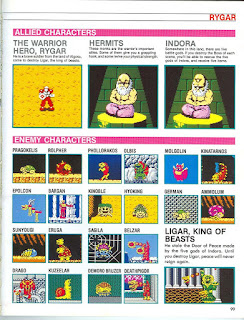I began this article during the 30 year anniversary of the game. I update this article occasionally with new visual themes & ideas.
A Beloved Video Game
At an age when video games tend to mean the most, I was a zealot of the so-called third generation of video games, one who played on 8-bit graphic consoles such as the Nintendo (NES) and Sega systems. The era produced hits such as 'Super Mario Brothers,' 'Zelda,' 'Contra,' and the original 'Sonic the Hedgehog.' I had a NES console. I spent the most time on Mario, 'Zelda,' 'Kung Fu,' 'Pro Wrestling,' 'Castlevania' and 'Dragon Warrior.' My favorite game in the 8-bit graphics world was 'Rygar.' It was set in an ancient mythological world. The hero, Rygar, was on a quest to destroy the leader of the dominant empire in order to restore peace to the land. Rygar had a flexible weapon which is somewhat similar to the type of weapon used by Simon Belmont from the game 'Castlevania.' The "Diskarmor" was a chain weapon with a shield at the end of the it, sometimes illustrated as more of a giant band saw.
Fig. 1 Rygar Arcade Flyer, Japan.
Like many games, the original version was first an arcade game, which usually had better graphics. Each console recreated the arcade game, each one taking on different aspects of the original game.
The Exercise
The visual themes of Rygar can serve as a fun exercise in assessing ancient themes. You should avoid ascribing intentions to the creators and designers of the game, and instead, think of this exercise as a game of dissecting an amalgamation and identifying the pieces.
The Discarmor
The discarmor was Rygar's main weapon. I can't think of an exact equivalent to this weapon in any cultural from any time-period. A shield that comes back to the user reminds one more of Captain America than some ancient hero like Herakles with his club, or Apollo with his bow.
The historical weapon (more like legendary) most similar to Rygar's discarmor, I think, is the flexible weapon which was thrown over the enemies head, as one pulled the cord, blades would open up inside the head bag and decapitate the one wearing it. This Chinese weapon is known in the west as the "Flying Guillotine."
Fig. A nice view of Rygar's discarmor in motion
Fig. The Flying Guillotine
The Diadem
The small crown was well known, especially seen on coins, in the ancient world. Alexander the Great wore a diadem with his mixed Persian and Greek garb.
The Persian King, Darius I. Behistun Inscription.
The Pants
Rygar is wearing pants. Why would this standout to an ancient historian? Greeks did not wear pants. As a matter of fact, they belittled cultures who wore the restrictive garments. The Greeks equated pant-wearing with the Persians. The "Other" wore pants.
The Shoes
In the assorted artwork related to Rygar, the shoe style is inconsistent. There is a lack of sandal and sandal style wraps in Rygar artwork, which indicate an ancient Greek ethnicity. Small shoes remind me of an ancient Persian item.
The Title
"Warrior of Argus." Argos? What heros in ancient Greek myth are from Argos? Perseus, for one.
Perseus
The Resurrected Warrior
In the Rygar story the hero is sometimes portrayed as a resurrected warrior. Other versions of the game has him as the new force taking over an old corrupt empire.
Resurrected Gods: Osiris (Egyptian), Dionysos (Greek), Quetzalcoatl (Aztec), Christ (Jewish), Mithra (Persia), Krishna (India).
Krishna, India.
The Meditating Sage
Along the way, the Hero of Rygar is aided by buff monks hidden inside caves and towers. These monks are seated in what looks like a classic meditation position reminiscent of Eastern Indian traditions. One sage even has a large third eye (Ajna), a staple of Indian religious systems.
The Survey
#Rygar looks like he is an ancient... [Survey for upcoming podcast]
If you had to choose, from what culture is the hero of the video game
#Rygar? I will be talking about this on my podcast soon. Please leave your comments below. Feel free to explain your answer if you like.

With all the jaguars he was jumping on in the early stages I assumed he was Incan. That was a great game, though.

Still love it to this day ....😉

I would vote for Incan as well

That box art doesn't look like the nes version. Or is it different from the EU box art?

This is not the nes version, good call. It is, I am told, a promo for the US arcade version.

Isn't the official story about a Greek hero that is resurrected to defeat evil? SEGA's Altered Beast has the same story BTW. I wonder if one of them stole the idea from the other?

From what I can find, the hero of Rygar is not mentioned as anything specific until the 2002 release, where he is intentionally Greek. It is possible the original makers intended the hero to be Greek, but the release from the late 80s (arcade and nes) shows imagery which is non-Greek. I don't want to give it away, I will be talking about it soon in my ancient history show. All in fun. Rygar was my all-time fav new game without a doubt.
Read more

+STBill u right I think rygar came out fitst

In the early ones Rome, in the ps2 one Greek. ?










 SteveDotson
SteveDotson

